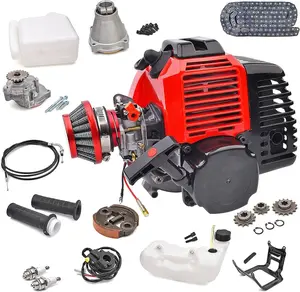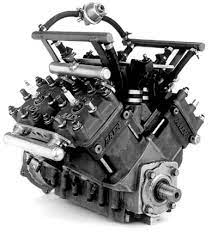Trailblazing Tech: The Two-Stroke Replacement Engine Phenomenon
The article explores the Two-Stroke Replacement Engine, addressing environmental and efficiency issues of traditional two-stroke engines. Advantages include improved fuel efficiency, lower emissions, and a high power-to-weight ratio. Examples of such engines are found in marine, recreational vehicles, and power equipment industries. Challenges include adaptation hurdles and initial costs. Comparisons between 2-stroke and 4-stroke engines highlight environmental concerns and shorter lifespans as drawbacks for 2-strokes. The article emphasizes the ongoing development of cleaner engine technologies and the shift towards more sustainable options.
Unleashing Efficiency and Environmental Innovation.

The world of engines is constantly evolving, and one of the latest innovations making waves is the Two-Stroke Replacement Engine. This powerful and efficient alternative to traditional engines has been gaining popularity for its unique design and impressive performance.
Understanding Two-Stroke Engines
Before diving into the replacement engine, it's crucial to understand the basics of a traditional two-stroke engine. Unlike its four-stroke counterpart, a two-stroke engine completes the combustion cycle in just two strokes of the piston—upward and downward. While these engines are known for their simplicity and lightweight design, they often suffer from higher emissions and lower fuel efficiency.

The Need for Replacement
The Two-Stroke Replacement Engine emerged as a response to the environmental concerns associated with traditional two-stroke engines. The latter tend to release a significant amount of unburned fuel and oil into the atmosphere, contributing to air pollution. The replacement engine aims to address these issues while maintaining the advantages of a two-stroke design.
Key Features of Two-Stroke Replacement Engines
- Improved Fuel Efficiency: One of the primary advantages of the replacement engine is its enhanced fuel efficiency. Through innovative design and technology, engineers have managed to optimize the combustion process, resulting in reduced fuel consumption.
- Lower Emissions: Environmental sustainability is a key focus in the development of Two-Stroke Replacement Engines. By incorporating advanced catalytic converters and cleaner combustion mechanisms, these engines significantly reduce harmful emissions, making them more eco-friendly.
- Enhanced Power-to-Weight Ratio: Just like traditional two-stroke engines, replacements maintain a high power-to-weight ratio. This makes them ideal for applications where lightweight and powerful engines are essential, such as in recreational vehicles and small-scale machinery.
- Direct Fuel Injection: Many Two-Stroke Replacement Engines feature direct fuel injection systems, improving precision and optimizing the combustion process. This not only contributes to better fuel efficiency but also minimizes exhaust emissions.
- Reduced Maintenance Requirements: Thanks to simplified designs and fewer moving parts, these replacement engines often require less maintenance compared to their traditional counterparts. This can result in cost savings and increased overall reliability.
Applications and Industries
The versatility of Two-Stroke Replacement Engines opens doors to various applications and industries. From recreational vehicles like motorcycles and snowmobiles to industrial use in chainsaws and generators, these engines are finding their place in a wide range of fields.
Advantages of Two-Stroke Replacement Engines
- Improved Fuel Efficiency: Two-Stroke Replacement Engines often boast enhanced fuel efficiency compared to traditional two-stroke engines. This is achieved through advanced combustion mechanisms and optimized designs.
- Lower Emissions: Environmental concerns associated with traditional two-stroke engines, such as high levels of unburned fuel and oil emissions, are mitigated in replacement engines. The incorporation of catalytic converters and cleaner combustion processes significantly reduces harmful emissions.
- High Power-to-Weight Ratio: Like their traditional counterparts, Two-Stroke Replacement Engines maintain a high power-to-weight ratio. This makes them well-suited for applications where lightweight and powerful engines are crucial, such as in recreational vehicles and small-scale machinery.
- Direct Fuel Injection: Many replacement engines feature direct fuel injection systems, improving fuel delivery precision and optimizing the combustion process. This not only contributes to better fuel efficiency but also helps in minimizing exhaust emissions.
- Reduced Maintenance Requirements: Simplified designs and fewer moving parts often result in reduced maintenance needs for Two-Stroke Replacement Engines. This can lead to cost savings and increased overall reliability.
Disadvantages of Two-Stroke Replacement Engines
- Adaptation Challenges: Transitioning from traditional engines to Two-Stroke Replacement Engines may pose challenges in terms of adapting existing infrastructure and systems. Compatibility issues with older equipment and technologies could slow down the adoption process.
- Initial Cost: The initial cost of acquiring Two-Stroke Replacement Engines may be higher than that of traditional two-stroke engines. While the long-term benefits, such as fuel savings and reduced maintenance costs, can offset this, the upfront investment may still be a deterrent for some.
- Resistance to Change: Industries and individuals accustomed to traditional engines may be resistant to adopting new technologies. Convincing stakeholders of the benefits and reliability of Two-Stroke Replacement Engines may require time and effort.
- Reliability Concerns: Depending on the specific design and technology, some Two-Stroke Replacement Engines may face initial skepticism regarding their long-term reliability. Proving the durability and longevity of these engines will be crucial for widespread acceptance.
- Limited Application in Certain Industries: While versatile, Two-Stroke Replacement Engines may not be suitable for all industries or applications. In specific cases where precise power delivery or specific emission standards are crucial, alternative technologies may be preferred.
Key Aspects
1. Environmental Considerations:
- Reduced Emissions: Traditional two-stroke engines are known for emitting higher levels of unburned fuel and oil, contributing to air pollution. Two-Stroke Replacement Engines aim to minimize these emissions through advanced combustion technologies and cleaner exhaust systems.
2. Improved Fuel Efficiency:
- Optimized Combustion: Two-Stroke Replacement Engines often incorporate innovative designs and technologies to improve fuel efficiency. Direct fuel injection, for example, allows for better control over the combustion process, reducing fuel consumption.
3. Enhanced Power-to-Weight Ratio:
- Performance Characteristics: Like traditional two-stroke engines, replacements maintain a high power-to-weight ratio. This makes them attractive for applications where lightweight and powerful engines are crucial, such as in recreational vehicles and small-scale machinery.
4. Advanced Technologies:
- Direct Fuel Injection: Many Two-Stroke Replacement Engines feature direct fuel injection systems, which enhance the precision of fuel delivery, leading to more efficient combustion and reduced emissions.
- Catalytic Converters: To further reduce harmful emissions, some replacement engines are equipped with advanced catalytic converters that help convert pollutants into less harmful substances.
5. Applications:
- Marine Engines: Outboard motors for boats have been a focus for Two-Stroke Replacement Engines. Companies are developing cleaner and more efficient marine propulsion systems to minimize the environmental impact of watercraft.
- Motorcycles and Recreational Vehicles: Manufacturers in the motorcycle and recreational vehicle industry are exploring these engines to balance power and efficiency in off-road and on-road applications.
6. Challenges and Considerations:
- Adaptation Challenges: Adapting existing infrastructure and convincing industries to shift from traditional engines to replacements can pose challenges.
- Cost Considerations: While long-term benefits in fuel savings and reduced maintenance costs are expected, the initial investment in Two-Stroke Replacement Engines might be higher.
- Reliability Concerns: Ensuring the long-term reliability of these engines is crucial for gaining widespread acceptance.
Challenges and Considerations
While the Two-Stroke Replacement Engine offers numerous benefits, it's essential to acknowledge the challenges it may face. Adapting existing infrastructure, addressing potential reliability concerns, and overcoming resistance to change within industries are all factors that need careful consideration.

FAQ
Can you replace a 2 stroke engine with a 4-stroke engine?
How long do 2-strokes engines last?
What is the main disadvantage of a 2 stroke engine?
Can you rebuild a 2 stroke engine?
Which engine is better 2 stroke or 4 stroke?
Which engine is more reliable 2 stroke or 4 stroke?
What are the problems with 2 stroke engines?
Why is 2 stroke engine no longer used?
1. Can you replace a 2-stroke engine with a 4-stroke engine?
- Yes, it is possible to replace a 2-stroke engine with a 4-stroke engine. However, this process may involve modifications to accommodate the differences in size, weight, and mounting points between the two types of engines. Additionally, the fuel and exhaust systems may need adjustments to match the requirements of the new engine.
2. How long do 2-stroke engines last?
- The lifespan of a 2-stroke engine can vary based on factors such as maintenance, usage, and the type of application. Generally, well-maintained 2-stroke engines can last between 20 to 200 hours of operation. In comparison, 4-stroke engines often have a longer lifespan due to their design and lubrication system.
3. What is the main disadvantage of a 2-stroke engine?
- The main disadvantage of a 2-stroke engine is its higher emissions, as it tends to release a significant amount of unburned fuel and oil into the atmosphere. This environmental concern has led to the development of cleaner alternatives, such as the Two-Stroke Replacement Engine mentioned earlier.
4. Can you rebuild a 2-stroke engine?
- Yes, 2-stroke engines can be rebuilt. Regular maintenance, including replacing worn-out parts and ensuring proper lubrication, is essential to extend the engine's lifespan. Rebuilding involves disassembling the engine, inspecting and replacing damaged components, and reassembling it for optimal performance.
5. Which engine is better, 2-stroke or 4-stroke?
- The choice between a 2-stroke and a 4-stroke engine depends on the specific application and requirements. 2-stroke engines are known for their simplicity, lightweight design, and higher power-to-weight ratio, making them suitable for certain applications like motorcycles and chainsaws. On the other hand, 4-stroke engines generally offer better fuel efficiency, lower emissions, and are more commonly used in cars and larger machinery.
6. Which engine is more reliable, 2-stroke or 4-stroke?
- The reliability of an engine depends on various factors, including maintenance, usage, and application. Both 2-stroke and 4-stroke engines can be reliable when properly maintained. However, 4-stroke engines often have a reputation for longevity and durability due to their more complex design and efficient lubrication systems.
7. What are the problems with 2-stroke engines?
- Some common problems with 2-stroke engines include higher emissions, a shorter lifespan compared to 4-stroke engines, and the need for a proper fuel-oil mixture. They also tend to be noisier and may have a less consistent power delivery compared to 4-stroke engines.
8. Why is the 2-stroke engine no longer used?
- While 2-stroke engines are still used in certain applications, their decline in popularity is attributed to environmental concerns regarding emissions. The release of unburned fuel and oil into the air has led to stricter emissions regulations, prompting the development of cleaner alternatives like the Two-Stroke Replacement Engine or the preference for 4-stroke engines in many applications.
The Two-Stroke Replacement Engine represents a significant step forward in the evolution of combustion engines. With a focus on environmental sustainability, improved efficiency, and versatile applications, this innovative technology is poised to reshape the landscape of various industries. As advancements continue, we can expect even more refined and powerful iterations of these engines, further contributing to a greener and more efficient future.



